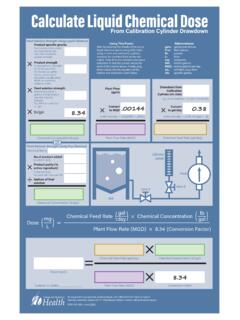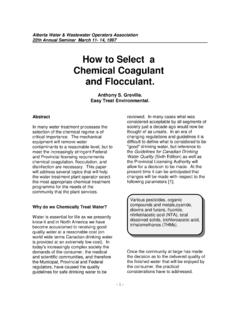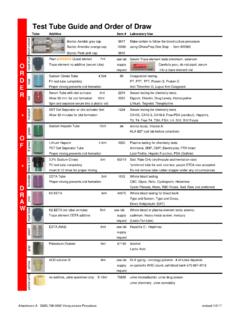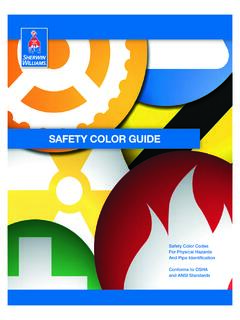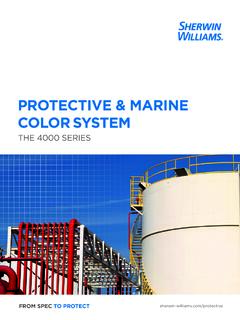Transcription of 6. Water treatment - World Health Organization
1 6. Water treatment . 71. 6. Water treatment Introduction Water can be contaminated by the following agents: Pathogens disease-causing organisms that include bacteria, amoebas and viruses, as well as the eggs and larvae of parasitic worms. Harmful chemicals from human activities (industrial wastes, pesticides, fertilizers). Chemicals and minerals from the natural environment, such as arsenic, common salt and fluorides. Some non-harmful contaminants may influence the taste, smell, colour or temperature of Water , and make it unacceptable to the community. Water from surface sources is often contaminated by microbes, whereas groundwater is normally safer, but even groundwater can be contaminated by harmful chemicals from human activities or from the natural environment.
2 Rainwater captured by a rooftop har- vesting system or with small catchment dams is relatively safe, provided that the first Water is allowed to flow to waste when the rainy season starts. The amount of Water to be treated should also be assessed. This can be estimated by assuming that each person will need a minimum of 20 50 litres of Water a day for drinking, cooking, laundry and per- sonal hygiene. A community should be consulted when choosing a Water - treatment system and should be made aware of the costs associated with the technology. In particular, community members should be made aware of the behavioural and/or cultural changes needed to make the system effective over the long-term and thus be acceptable to them.
3 Communi- ties may also need to be educated about protecting Water sources from animal or human contamination, and mobilized. It should be emphasized that all the positive effects of a Water - treatment system could be jeopardized if the Water is not drawn, stored and trans- ported carefully and hygienically. The Fact Sheets in this section deal with both community and household methods for treating Water . Some household treatment methods and their effectiveness are summa- rized in Table , whereas the following household and community Water - treatment technologies are described in greater detail: Household Water - treatment systems boiling.
4 Household slow sand filter;. domestic chlorination. Community Water - treatment systems storage and sedimentation;. up-flow roughing filter;. slow sand filtration;. chlorination in piped Water -supply systems. LINKING TECHNOLOGY CHOICE WITH OPERATION AND MAINTENANCE. 72. TABLE HOUSEHOLD Water - treatment SYSTEMS AND THEIR EFFECTIVENESSa Effectiveness over factors that affect Water quality Bacteria, Guinea- Odour, Organic treatment system amoebas worm Cercaria Fe, Mn Fluoride Arsenic Salts taste matter Turbidity Straining through fine cloth Consists in pouring raw Water b . through a piece of fine, clean, cotton cloth to remove some of the suspended solids.
5 Aeration Oxidizes iron (Fe) and mang- . anese (Mn). Good aeration of the Water is also important for slow, sand filtration to be effective, especially if there is not enough oxygen in the surface Water . Water can easily be aerated by shaking it in a vessel, or by allowing it to trickle through perforated trays containing small stones. Storage/pre-settlement Storing Water for only one day . can eliminate some bacteria, but it should be stored for 48. hours to eliminate cercaria (snail larvae). The longer the Water is stored, the more the suspended solids and pathogens will settle to the bottom of the container. The top Water can then be used after sedimentation.
6 Coagulation, flocculation and settlement In coagulation, a liquid coagu- . lant, such as aluminium sulfate, is added to the Water to attract suspended particles. The Water is then gently stirred to allow the particles to come together and form larger particles (floccula- tion), which can then be removed by sedimentation, settlement or filtration. The amount of coagulant needed will depend on the nature of the contaminating chemical compounds and solids. Slow sand filtration Water passes slowly downwards . through a bed of fine sand at a steady rate. The Water should not be too turbid, otherwise the filter will get clogged.
7 Patho- gens are naturally removed in the top layer where a biological film builds up. A potential problem is that some house- holds do not use this technology effectively and the Water can remain contaminated. a Adapted from: Skinner & Shaw (1998). b The treatments were categorized as being: of no effect, or of unknown effectiveness ( ); of little effect ( ); moderately effective ( ); highly effective ( ). 6. Water treatment . 73. TABLE CONTINUED. Effectiveness over factors that affect Water quality Bacteria, Guinea- Odour, Organic treatment system amoebas worm Cercaria Fe, Mn Fluoride Arsenic Salts taste matter Turbidity Rapid sand filtration The sand used is coarser than.
8 In slow sand filtration and the flow rate is higher. The method is used to remove suspended solids and is effective after the Water has been cleared with coagulation/flocculation. There is no build-up of biological film, hence the Water will still need to be disinfected. It is easier to remove trapped debris from upflow sand filters, compared to filters in which the Water flows downwards. Charcoal filter Granular charcoal (or granu- . lated activated carbon) can be used in filtration and is effective in improving the taste, odour and colour of the Water . How- ever, it should be replaced regularly, because bacteria can breed in it.
9 Ceramic filter The filter is a porous, unglazed . ceramic cylinder and impurities are deposited on its surface. Filters with very small pores can remove most pathogens. Open, porous ceramic jars can also be used. The ceramic filter method can only be used with fairly clear Water . Solar disinfection Ultraviolet radiation from the . sun will destroy most patho- gens, and increasing the temperature of the Water enhances the effectiveness of the radiation. In tropical areas, most pathogens can be killed by exposing the contaminated Water to sun for five hours, centred around midday. An easy way to do this, is to expose (half-blackened) clear glass/.
10 Plastic bottles of Water to the sun. Shaking the bottle before irradiation increases the effectiveness of the treatment . The Water must be clear for this treatment to be effective. LINKING TECHNOLOGY CHOICE WITH OPERATION AND MAINTENANCE. 74. TABLE CONTINUED. Effectiveness over factors that affect Water quality Bacteria, Guinea- Odour, Organic treatment system amoebas worm Cercaria Fe, Mn Fluoride Arsenic Salts taste matter Turbidity Chemical disinfection Chlorination is the most widely . used method of disinfecting drinking- Water . Liquids (such as bleach), powders (such as bleaching powder), and purpose-made tablets can be used.










